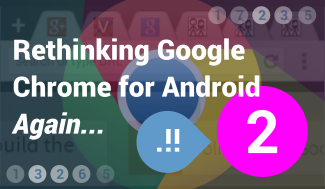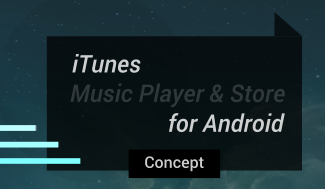

|
Viewout
|
|
|
Concept on March 17, 2014 at 21:42
In a recent article I discussed the need of a new way to manage your tabs on Google Chrome on Android and on mobile phones in general. The basic idea was to replace the iconic card-interface with a Navigation Drawer, though at the end I concluded that Google definitely has to figure out how to bring mobile browsing finally to a whole new level, but that this particular implementation wouldn’t be the right way to achieve this.
So again I’ve taken some time and worked on another, slightly different idea. As shown above, this time I’m aiming even more for a desktop-inspired interface, placing real tabs on the very top. Google has already something very similar for Chrome on tablets, but this concept goes a bit further, adding new gestures to manage tabs better also on touch devices. The same ideas might easily be added to the tablet version, too. As you can see, the tabs look pretty similar to pinned tabs on the desktop. Swiping a tab down closes it, which I think is a very quick way and can be infinitely useful. If the user has more than about 5 or 6 tabs open, he can of course scroll horizontally through the list of tabs - just like on the tablet version too. Tapping twice on a tab gives the possibility to reposition it.
|

|
|
Concept on March 15, 2014 at 16:25
Google has added so-called Navigation Drawers to all of it’s mobile applications throughout the last year. And they are not finished with them yet: the first apps do already start to receive new updates going even further by placing also “Help” and “Settings” into the drawer, thus replacing the Action Overflow Button completely.
There's no doubt that Navigation Drawers are the new way to get around on Android. And it’s also a really great, intuitive and innovative way. So - why shouldn't Google Chrome get such a drawer too? It sounds totally insane at first, but it actually makes much more sense than you might think. The idea is - as shown above - that your browser tabs are no longer listed in Chrome’s iconic 3D card interface, but in a new Navigation Drawer on the left. Everything else, as for example tab-switching by swiping left or right, would stay the same. The great advantage of such an implementation would be that more tabs could be shown at once. |

|
|
Concept on January 26, 2014 at 13:02
With the release of Google Maps for iOS, Google decided more than one year ago to take iOS really seriously and to create really gorgeous apps for the system. The latest applications to join this list of great Google apps on iOS were Google Play Music and Google Play Movies & TV. The main reason for the adaption was probably Google’s new music streaming service Google Play Music All-Access. Nevertheless, I personally began purchasing songs from Google Play now, because all my songs are now synced across my Windows PCs, my Android Smartphones and Tablets, as well as on my old iPod Touch. And because of this I noted at the end of my article about a possible web adaption of Google Play Newsstand that “being extremely limited and short-sighted, Apple cannot even offer me half of what Google already does”. But why not?
Why shouldn't Apple release a version of iTunes for Android? I really thought very much about this idea and came to the of course already expected conclusion that such an adaption would make absolutely no sense for Apple, which I'm also going to point out in just a minute. But I really like the idea of iTunes for Android and so I created some mockups (4) imagining what such an app might look and feel like. |

|
